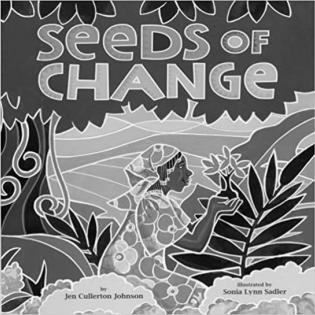Seeds of Change Literature Guide
This true story of Wangari Mathaai, the first African woman to win the Nobel Peace Prize, is an inspiring tale of environmental activism and the power each one of us has to help protect our world.
Literature Guide by Maureen Klein
Before Reading
Ask: What do you know about seeds? Prompt the reader to consider the size and color of seeds and what their function is. What things grow from seeds?
Show: Show the front cover of the book. What do you notice about the woman on the cover? What is she holding?
Connect: We’re going to read the true story of Wangari Mathaai. Listen for the ways Wangari’s life changed and grew like a seed and for the ways she used actual seeds to help her country.
During Reading
Ask: Wangari left her home and her country to become a scientist. Describe how Wangari might have felt when she made such a big decision.
Show: Show the page that begins “Wangari had an idea as small as a seed but as tall as a tree that reaches for the sky.” What was Wangari’s idea? Who did she get to help with her idea?
Connect: Wangari’s idea wasn’t welcomed by everyone. The book says, “Some men laughed and sneered.” How did Wangari respond to being told she was “too outspoken” or the work was not “women’s work”? Has anyone ever told you that you couldn’t do something?
After Reading
Ask: What obstacles did Wangari have to overcome? What can you do when you meet an obstacle?
Show: Show the page that begins, “Wangari began to travel, telling her story to teachers, presidents, farmers, ambassadors, and school children all over the world.” Look closely at the leaves on the tree. What do you notice? The title of the book is Seeds of Change. What “seeds of change” did Wangari plant when she shared her story? What change was she hoping to inspire in others?
Connect: What qualities or attributes would you use to describe Wangari? How did she change over the course of her life? Which quality stood out to you the most? How might you follow her inspiration?
Activities
- Watch the “I will be a Hummingbird” video clip of Wangari Mathaai. Brainstorm ways you can help the environment where you live. How can you be the best you can?
- Learning to Give’s TeachOne for Earth Day Unit guides learners to see other points of view as they identify environmental issues in their schools or local community. With a goal of building peaceful and inclusive communities (UN Sustainable Development Goal #16), listening to others' perspectives is key to moving forward. These activities are a perfect complement to the story of Wangari Mathaai.
- Show the page that begins, “Wangari began to travel, telling her story to teachers, presidents, farmers, ambassadors, and schoolchildren all over the world” Look closely at the leaves on the tree, what do you notice. Imagine the ways you might “plant seeds” in your community. Create a collage or painting of what planting your seeds might look like.
- Each one of us has the power to make a difference. We can celebrate acts of service through the practice of generous listening by interviewing a family member or neighbor. Invite them to share stories of philanthropy or volunteering they have done throughout their lives.
- “It's the little things citizens do. That's what will make the difference. My little thing is planting trees” (Wangari Mathaai). Even in the winter we can prepare for the spring. Construct your own mini-greenhouse to grow plants to share in the spring with this winter sowing service project.
